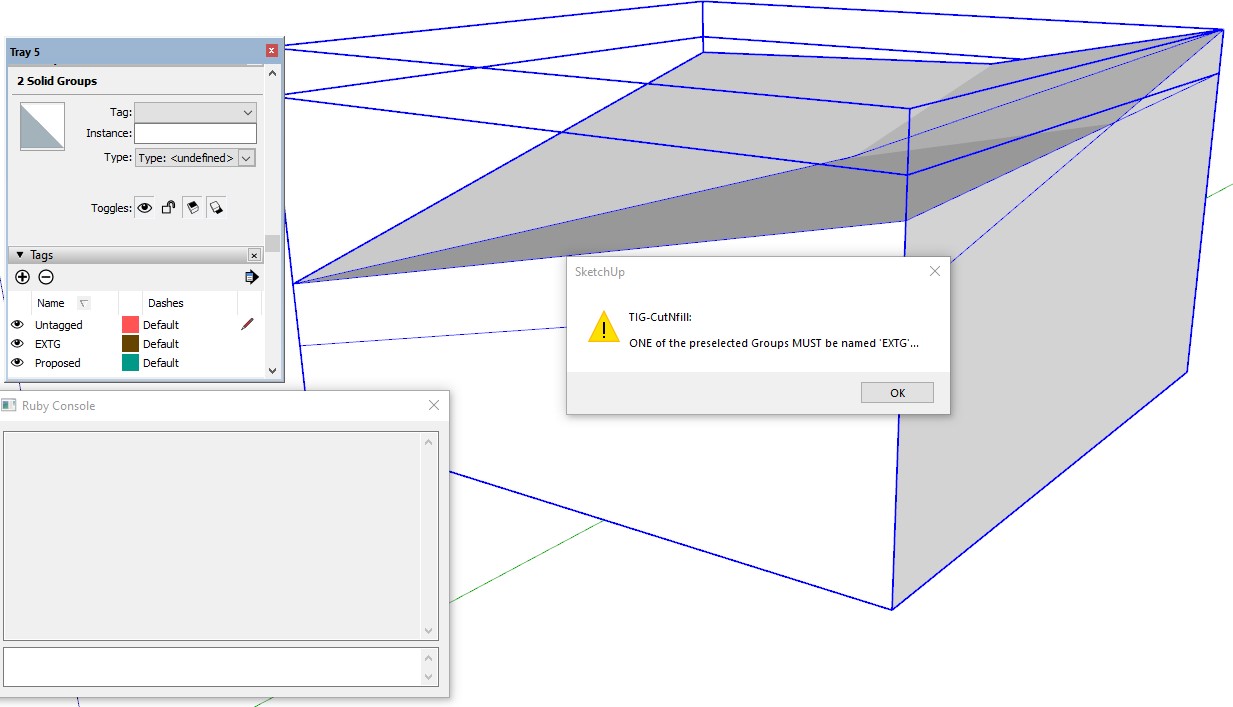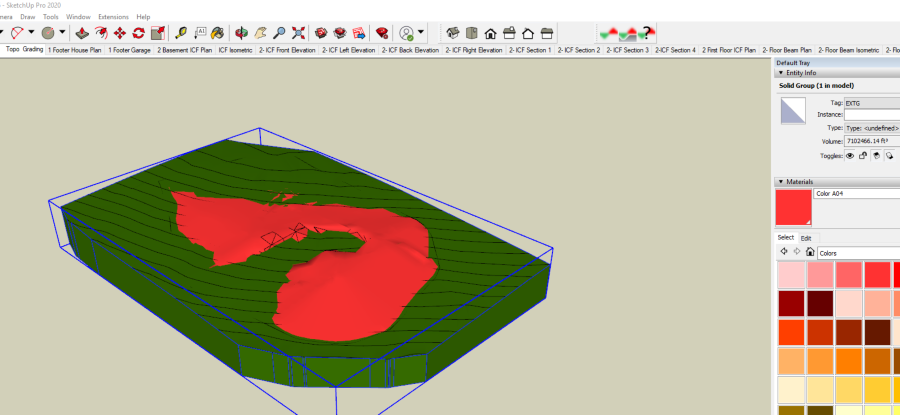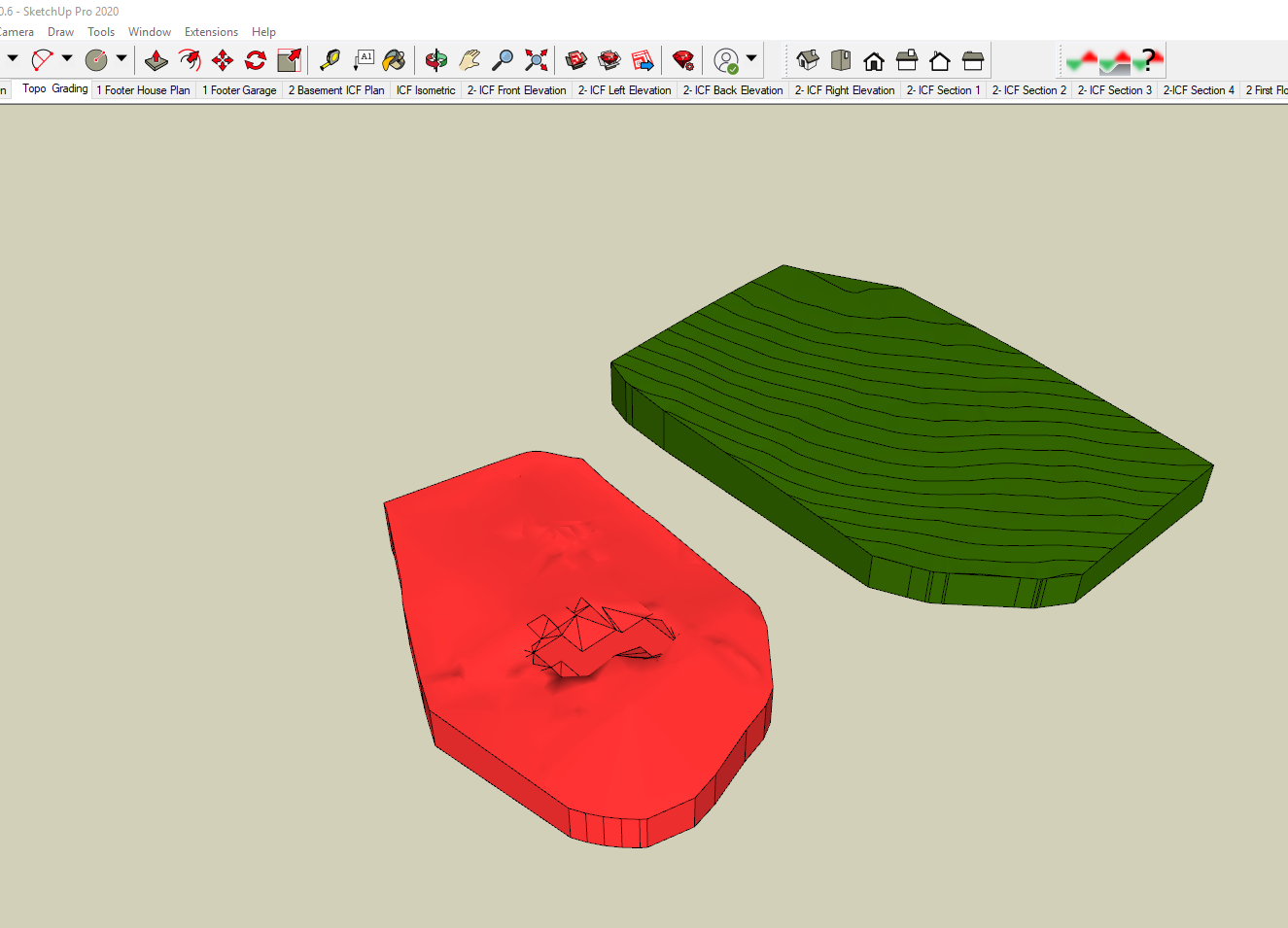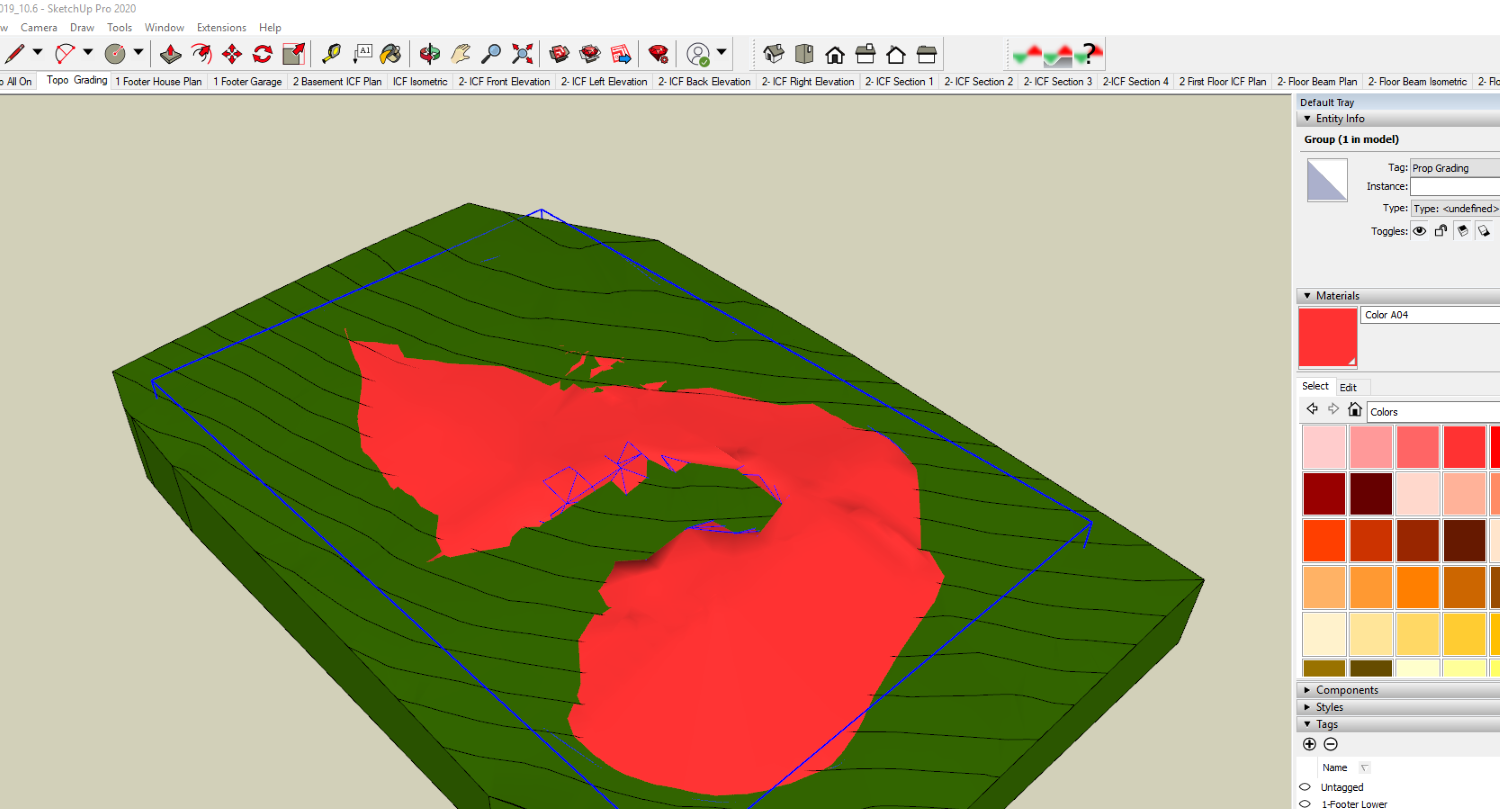[Plugin][EVAL] TIG-CutNfill
-
@skugee said:
I purchased a license for CutNfill...
I re-sent the download link to both of your email addresses today. Please let us know if you received it.
-
I've installed the licensed V3.0
I'm using SketchUp 2020
Couldn't get it to work so thought I'd try a simple shape, but still no joy?
restarted a few times, renamed group EXTG, but nothing seems to work.
anything else I can try?

-
Can you attach the simple SKP if the following steps don't solve things...
From the 'Entity Info' I can't see a group named EXTG ?
However since you've selected two groups no Instance name will be displayed.
The error message tells you one of the two groups needs to be named EXTG - that is NOT the Tag [Layer] name, it's the group-name [now recast as Instance-name]...
Select just the 'existing' group and in Entity Info give it the Instance name of EXTG.There is a Tag named 'EXTG', and the two selected groups have different tags, but none of this is important to this tool's functionality.
I usually name the two groups EXTG and PROP - but only the 'existing' one needs the name... this is so the tool can work out which is which in the processing...
I'd also recommend leaving the two groups with their Tag set to Untagged [or Layer=Layer0 <= v2019]
-
Ok I must be an idiot. I have installed the Cut N Fill plug-in by TIG and have followed the instructions and have the existing group titled “EXTG” but it keeps telling me one of the groups needs to be titled “EXTG”…it is, it won’t do anything else. I have tried exploading and regrouping and nothing seems to work. What am I doing wrong? Is there anyway to get help from TIG?
Note: I bought the plug-in so not operating under a trial
-
As I said over at SketchUp.com...
You need to select two overlaid groups.
The existing group must always be named 'EXTG', the proposed group can be named anything else you like - I use 'PROP'osed.
Note it must be two 'groups'... NOT component instances or their definitions.
Also the two groups must be 'solids' - otherwise the SketchUp 'solid-tools' can't work...Entity Info and the Outliner will show a selected group/properties and its name etc...
Please post with screen shots of your model, Entity Info etc...
I’m sure it will be a straightforward fix... -
Thanks for the reply, sorry got busy on other stuff. I think I know what the issue may be BUT I don't know how to fix. The error message kept saying one of the groups has to be named EXTG which you can tell from the attached images that one of them is named correctly. What I think the issue is when you look at the entity info for the proposed you will notice it doesn't report a volume. I used the skirt tool which hopefully you can also see in the attached image. So if this is the issue then the error message is throwing me off. Now if that is the issue then I don't know how to fix.
One thing worth mentioning is maybe I broke the surface when I made one edit. I created a surface from proposed contours and then used the skirt tool to turn the surface into a volume. These proposed contours did not properly account for the basement dig out so I attempted to delete some triangles and add in some triangles to account for the basement dig out (which is why it looks funky in the middle of the proposed surface. Now, I did this down and dirty as a test to get this cut and fill to work. I had planned to go back and do a better job once I got this thing to work. So, perhaps I broke the volume when I edited the surface. If that is the case, then how do you recommend getting a volume surface that represents your finished grade PLUS a basement dig out. Hopefully this makes sense.......but to be honest I am stabbing marbles with a fork.
thank you



-
You haven't quite started on the right foot...
Your EXTG & PROP groups must both be shown as 'solid' in Entity Info [with a volume] - otherwise SketchUp itself can do 'subtraction' etc...
Also they must both have the same 'footprints' from their 'skirts' - otherwise the resultant cut/fill volumes will be skewed by the differences...
So your 'PROP' group cannot have a different bottom 'footprint' compared to the 'EXTG' group.
They must also be exactly overlaid for the process to have a chance of working out the differences.If you have accidentally made something into 'non-solid', then you need to use a tool like Solid-Inspector to find out what's gone wrong - sometimes it can fix things, but other times you need to do a manual repair... My SolidSolver is another extension to consider...
Remember that a 'solid' must consist of only edges and faces, and every edge must support just 2 faces - no more, no less.
This means the surface cannot have any 'holes', 'flaps' or 'shelves', and no internal partition faces etc, where some edges will have 3 or more faces...Use View > Hidden Geometry > ON, to see all of the 'smoothed' edges in the surface - this will aid you when you try to heal holes and need to over-draw an edge etc...
-
Was this plugin ever available for SU version 8? Or is it a post 8 application only?
-
I do have an old version [v2.0] which is compatible with v8.
However, it's not as good as the newer version which are incompatible with v8.
I could PM you an EVAL [10 uses] version RBZ if you want it.
There is a v8 licensed version RBZ too, but for that I need proof of you buying it... -
@tig said:
I do have an old version [v2.0] which is compatible with v8.
However, it's not as good as the newer version which are incompatible with v8.
I could PM you an EVAL [10 uses] version RBZ if you want it.
There is a v8 licensed version RBZ too, but for that I need proof of you buying it...That'd be great TIG, I've DM'ed you my personal email in case it can't be sent on here.
cheers, Nigel -
I've PM'd you the old EVAL RBZ...
-
Here's the EVAL version v4.0
https://sketchucation.com/pluginstore?pln=TIG-CutNfill
Following feedback...
Reconfigured & re-signed for newer versions.
Options added for results 'colors', layers/tags, +/-ve clarified etc.A licensed version is now available for purchase/download from the SketchUcation Shop.
If you already have a licensed version, then downloading and installing the EVAL version will update your installation to v4.0... and your existing license will still work...
-
Hi all trying to cut and fill this split level into a site any one help as to why its not working, novice sketchup here the tool looks amazing once I get it going it will be invaluable for calcs!
-
Your groups are not 'solids', therefore it's impossible to subtract one from the other.
Add a 'skirt' to the 'EXTG' group.
It needs to report as 'solid' in Entity Info...
SolidInspector² can report and perhaps fix issues if it's not solid.
When it is solid make a copy of that group, move it off to the side.
Name the copy 'Proposed'
Now add the changes to the terrain...
Relocate the two groups over each other, using the lower parts of their skirts to ensure snapping...
Now you can select both of them and then CutNfill should calculate the differences...Note that your model as presented contains several reversed faces - you should only see the off-white front-faces, never the blue back-faces.
Whilst reversed faces in themselves should not adversely affect 'solid' operations, they are poor practice, and later on they can mess up 3d-printing and many rendering apps... -
Hi Tig just to thank you for your advise.
I found if I had blocked the EXTG earlier and then blocked the proposed later it wouldn't work. However each time I modify my proposed I simply just explode the EXTG and block each one individually with out moving them in the screen. this seems to work every time then.
-
Always get 0, 0 for the results. If this is an inherent problem with sketchup, then this plug-in is useless
-
If you follow the simple steps that are explained in the usage notes... and the Proposed and Existing forms are both solids, and they have a difference in their volumes, then the results should not be 0|0
If you post a simple example model where you are having issues, then perhaps helpful advice will result...
-
@tig said:
As explained in some earlier posts, it is possible to contrive two solid surface forms which when subtracted do not result in solid object [a limitation of SketchUp itself], so then the result has no volume - simply because it's not a solid.
You can get this result using the native tools rather that this specialist version of it - which actually uses the native tools via the API...Obviously start with two solid existing and proposed groups...
To try to avoid these kinds of issues then ensure that their skirts coincide exactly.
The tool has a built-in skirt adder tool...Next ensure that the existing and proposed groups have difference in their surfaces that are sensible.
A few mm difference in the elevations of their surfaces' faces is likely to result in a subtracted form with holes in it - because SketchUp can't create edges < 1/1000" long during the intersection and 'solid-tools' operation, so then faces that would have used those skipped tiny edges fail, and then the resultant form is not a solid and therefore it has no volume.
Remember that you are considering earth movement here, and accuracy to a few mm is not practical anyway, so be 'bold'...Hey, @Tig this sounds exactly like what I'm experiencing with my grading project. Solid inspector and entity info show solid groups for EXTG and PROP, but not getting a solid result from the cut n fill calculation.
Hoping you would be able to take a quick look at the file attached and give any guidance on how to avoid these tiny discrepancies.
Thanks!
-
I think your problem is as you suspect...
The two surfaces are incredibly detailed, so the chances are that you'll get tiny differences in the subtraction results, where tiny edges get auto-omitted and no face forms - rendering the result non-solid with 0 volume...
Since cut-and-fill is in reality an inaccurate science on site, can I suggest you try with a less subdivided mesh to start with...
The rogue out-liner might also suggest that the two forms' skirts are not coincident, which can have awkward results...You will get the equivalent result [non-solid 0] if you use the basic 'solid' subtraction on the two forms...
-
@tig said:
I think your problem is as you suspect...
The two surfaces are incredibly detailed, so the chances are that you'll get tiny differences in the subtraction results, where tiny edges get auto-omitted and no face forms - rendering the result non-solid with 0 volume...
Since cut-and-fill is in reality an inaccurate science on site, can I suggest you try with a less subdivided mesh to start with...
The rogue out-liner might also suggest that the two forms' skirts are not coincident, which can have awkward results...You will get the equivalent result [non-solid 0] if you use the basic 'solid' subtraction on the two forms...
Great feedback thank you! I got it working now! The most important things were:
taking down the detail of the mesh. I got it working with approx. 4' grid which is a good accuracy range for earthwork I think.
closely analyzing and repairing topo line connections with TopoShaper
I also found that it's okay to grade the edges of the mesh with the artisan brush as long as you hold shift to lock the vertex adjustments vertically, so that you don't mess up the mesh boundary.Awesome plugin, thank you so much!
Advertisement







